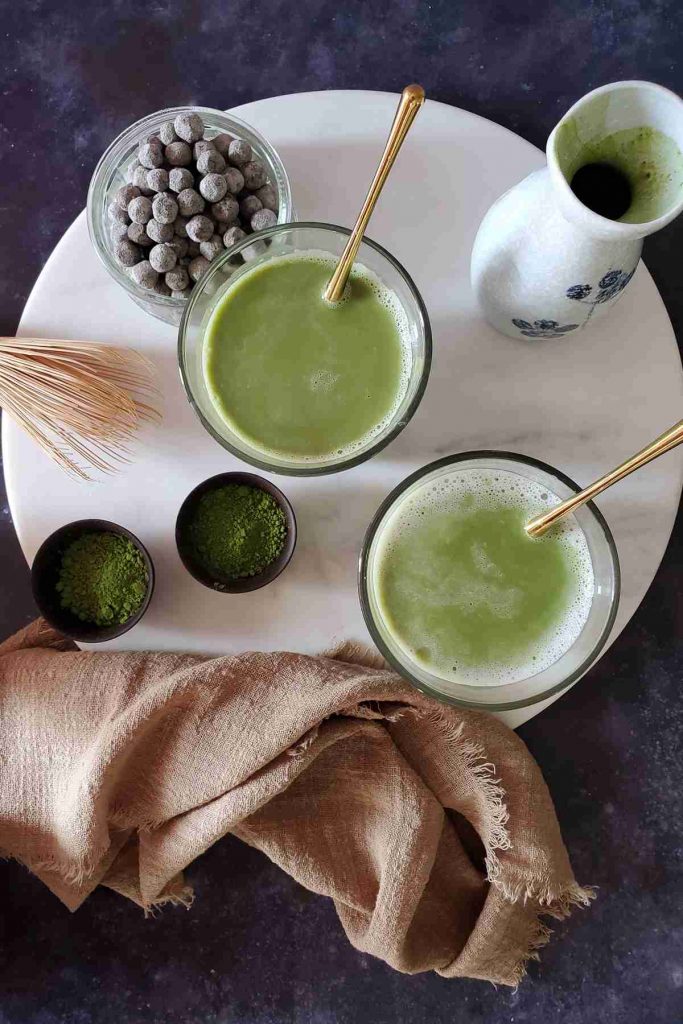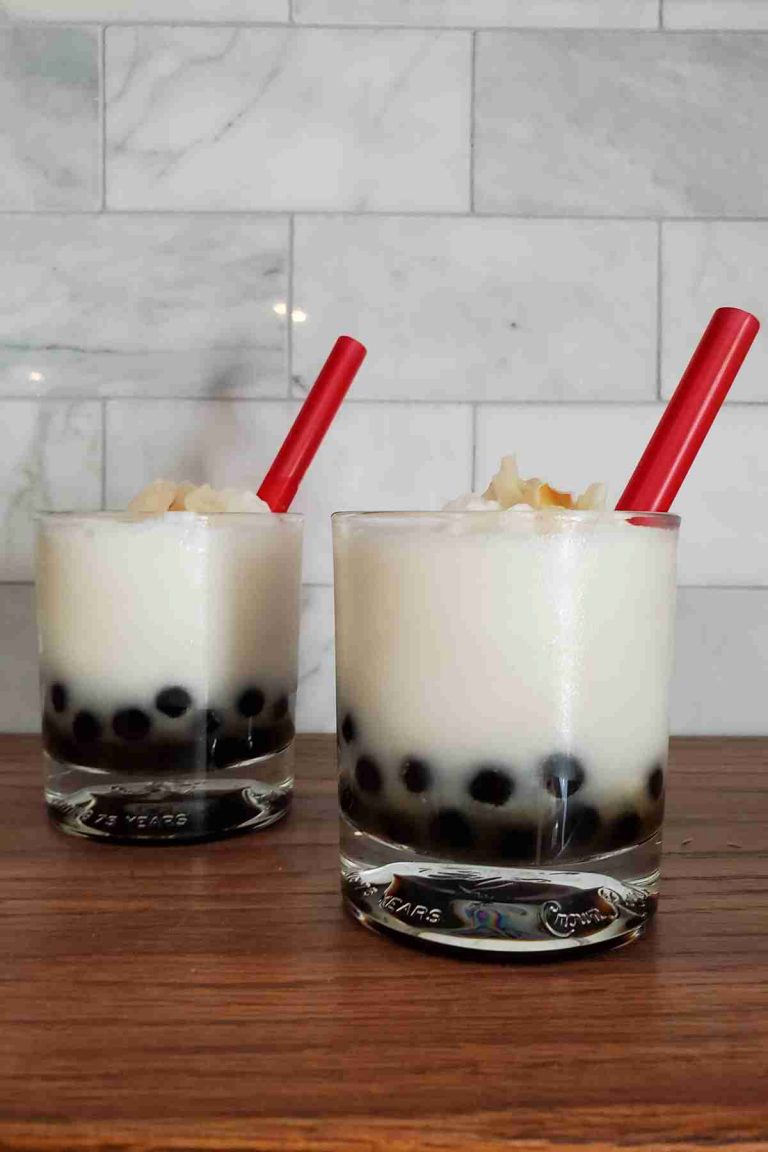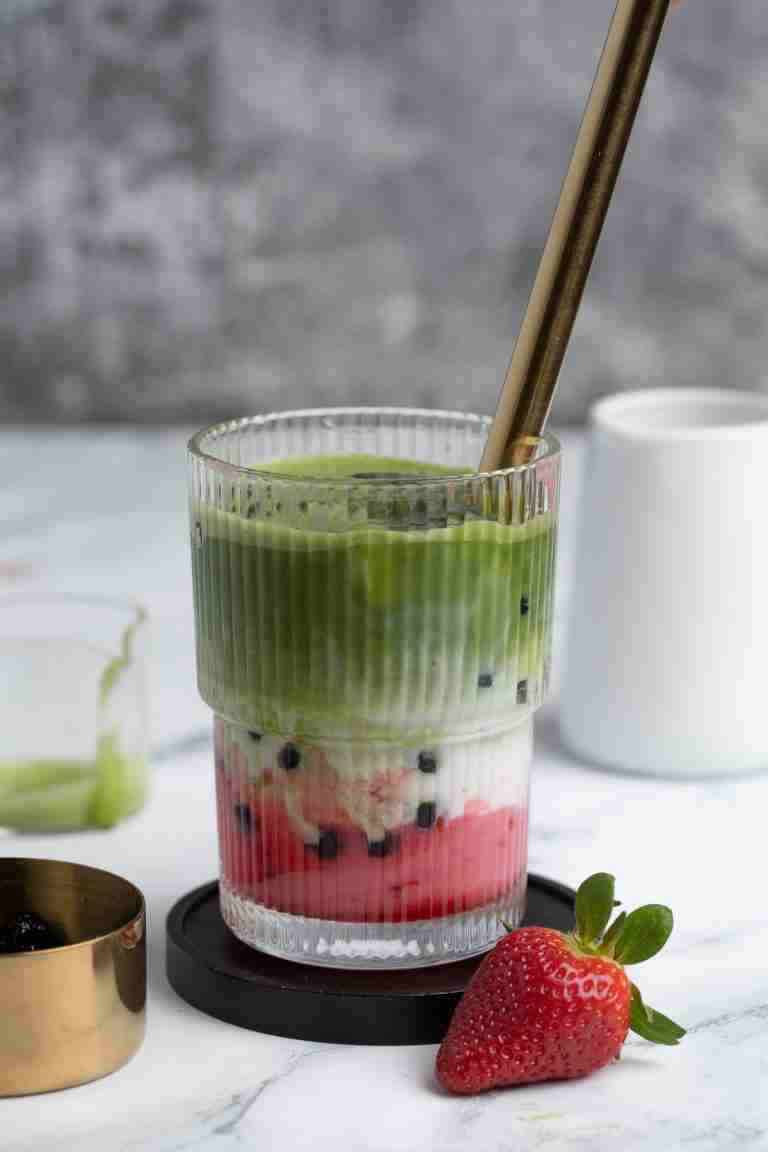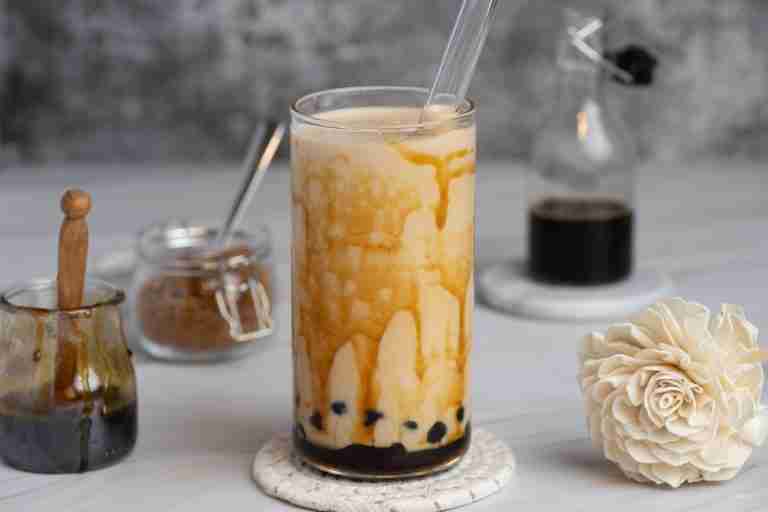This matcha milk tea recipe is creamy, sweet, and super easy to make. Top it off with brown sugar boba (aka chewy tapioca pearls) and a fat straw to make this drink fun and exciting.
I used to drink a lot of coffee before I discovered matcha. Matcha is a good replacement for caffeine because it doesn’t give you a headache after drinking it. Matcha provides steady energy without the crash, which makes it a popular choice for coffee and tea lovers alike.
This vibrant, creamy green-tinted drink goes by many names, like matcha milk tea, matcha latte, or matcha green tea latte. Coffee shops serve it cold and call it an iced matcha milk tea or iced matcha latte. Tea shops call it matcha bubble tea or matcha boba tea.
One thing most people don’t think about matcha is how it is prepared. Many coffee shops use an artificial sugar-laced matcha powder. My matcha milk tea recipe uses real matcha, creamy milk, and a simple sugar syrup.
The secret for this recipe is my secret tested ratio to get that beautiful green color and creamy taste without overbearing bitterness from the tea. Read on to find out the perfect ratios!

Contents
- 1 The secret ratios
- 2 How much caffeine is in matcha?
- 3 Benefits
- 4 Matcha quality
- 5 How to whisk matcha
- 6 Milk choices
- 7 What you need
- 8 How to make matcha milk tea
- 9 Expert tips & notes
- 10 What to eat with it?
- 11 Storing
- 12 Reheating
- 13 Variations
- 14 FAQs
- 14.1 Can you make this with matcha tea bags?
- 14.2 Does a cold-brewed matcha tea have the same health benefits as a hot-brewed?
- 14.3 What temperature should I heat water for matcha?
- 14.4 What’s the best matcha grade?
- 14.5 What kind of matcha does Starbucks use?
- 14.6 Can I drink this while pregnant or breastfeeding?
- 15 The Best Matcha Milk Tea Recipe (with Brown Sugar Boba)
The secret ratios
Ok it’s not so much a secret once you find out how easy this is! I’ve tried all different variations and I’ve found this ratio to be the best across the board. It’s 1 part milk, 1 part hot water for a small cup. This is with 1 teaspoon of matcha. You can add more matcha if you like it stronger, more milk if you want it creamier, but this is a great starting point for a hot cup of matcha.
Read on to learn about matcha and how to customize your drink.
How much caffeine is in matcha?
One teaspoon of matcha contains about 68 mg of caffeine. This matcha milk tea recipe uses 1 teaspoon per serving. If you want even more caffeine, try my Iced Matcha Coffee.
Benefits
Matcha green tea contains L-theanine. This molecule helps your body absorb caffeine more slowly, which gives you a steady energy as opposed to coffee, where you may end up having a caffeine crash. L-theanine increases dopamine (the “happy hormone”) in your body, which has a calming effect and reduces stress and anxiety.
Matcha green tea provides antioxidants, aids in weight loss, and controls diabetes. It helps protect the immune system, heart and brain. It is also thought to protect against cancer, and help prevent cardiovascular disease and metabolic disorders.*
Matcha quality
Matcha is a specific type of green tea that comes from the Camellia sinensis plant in Japan. The tea leaves are ground into a fine green powder. Quality and types of matcha vary greatly depending on how it’s prepared.
You want to make sure you choose a good quality matcha so that it tastes the best in your recipe. Check the ingredient label on the packaging. If you see anything other than matcha, then it’s not pure.
Real, high quality matcha powder is bright green, smells a little grassy, and has a fine powder texture similar to baby powder. It should feel fine and silky like how eye shadow or baby powder feels like.
This article will explain more about matcha and show you exactly how to select the matcha you need.
Here is the matcha powder I recommend. It checks all the boxes in terms of quality, price, and freshness.
How to whisk matcha
There is a special technique for preparing matcha. It is easy but requires a special tool. You will need a bamboo whisk, also known as a matcha whisk.
In a small bowl, add 1 teaspoon, and ¼ cup hot or cold water. Whisk, very briskly, back and forth in a straight line in a M or W shape for about 20-30 seconds.
The goal is to remove all the clumps and create little foam bubbles. Keep whisking and the clumps will dissolve away.
Pro Tip: Whisk matcha, very briskly, back and forth in a straight line in a M or W shape for about 20-30 seconds until all the clumps are gone.
Milk choices
The choice of milk will greatly influence the flavor of your matcha milk tea. My favorite milk are listed in order below:
- Oat milk. This is creamy, great for frothing, and highlights the flavors of matcha. The oat flavor is subtle, and can taste like traditional milk in the right amount. This one is my favorite brand.
- Soy milk. This brings out the sweetness in the matcha. I like the taste of soy milk in slightly bitter tea drinks. I think the soy cancels out the bitter very well, making it much smoother. I like this one.
- Almond milk. This has a sweet and lightly nutty flavor that compliments the matcha. It’s a very light milk, so it doesn’t compete with the color of matcha much. Almond milk retains the most nutrients in this drink.
- Coconut milk. This makes it coconut-y and brings a whole new element to matcha. Coconut milk also retains the most nutrients in this drink.
- Non-diary milk. Other alternatives are cashew milk, pea milk. I prefer almond milk first.
- Dairy milk. I like whole milk for the fatty, wholesome flavor. Others may prefer a lighter milk, like 2% or skim, but I don’t recommend that because the end product will be too watery.
- Any other creamy milk.
What you need
Matcha & Equipment
Matcha. Any culinary grade matcha will work for this recipe. You don’t need to go for a ceremonial grade matcha, just a good quality matcha (I show you what to look for in my Matcha Guide). This is the matcha powder brand I use for taste, price, and accessibility. If you want to splurge, my cousin San (a supertaster) recommended me try Encha organic matcha powder, a ceremonial grade matcha, and I love it. Encha also makes a latte grade powder too.
This recipe calls for 1 teaspoon of matcha per serving. To personalize it to your taste, add ½ teaspoon more to have it stronger, take away ½ teaspoon to make it lighter.
You’ll also want to invest in a matcha whisk aka bamboo whisk. This is the traditional way, and my best recommendation for the smoothest matcha drink. Invest in a matcha whisk like this one to properly whisk matcha. That link also includes a measuring spoon for the matcha.
If you don’t have a matcha whisk, try a regular whisk, mason jar, shaker, bottle, or milk frother. See Expert Tips for details on how to use each tool.
Properly whisking your matcha will prevent clumps. Clumps cause the drink to taste more bitter and chalky.
A strainer can be used to remove the clumps. I like this small fine mesh tea strainer.

Milk tea
Boba (aka pearls, bubbles, or tapioca balls). You can buy it here. It’s cheaper in Asian grocery stores, if you are close to one.
Your favorite milk, such as oat, soy, almond, or non-dairy milk.
A sweetener. My favorite is a dark brown sugar simple syrup. I usually use 1-2 teaspoons of this sweetener. You can use this brown sugar syrup to let the boba rest in and absorb the sweetness too.
Other sweetener options are maple syrup, agave syrup, white sugar, brown sugar, dark brown sugar, or regular cane sugar. Start with 1 teaspoon and add your way to your desired sweetness.
Boba
This is the boba I use.
For the boba you bought, I recommend starting with the instructions. If it’s not chewy and sweet enough for you, then use my Brown Sugar Boba recipe to make taste better.
Pro Tip: I recommend to make Brown Sugar Syrup to make the boba sweet. I usually do this while the boba is cooking. After the boba has cooked, I strain it and put it in the syrup for at least 30 minutes.
How to make matcha milk tea
- Prepare the matcha mixture. In a small bowl, add 1 teaspoon, and ¼ cup hot or cold water. Whisk very briskly back and forth in a straight line in a M or W shape for about 20-30 seconds until all the clumps are gone.
- Add ¾ cup steamed milk (or cold milk if you want it iced).
- Add cooked boba (aka pearls, bubbles, or tapioca balls) to your cup.
- Add sweetener to taste.
- Add ice if you want it cold. Otherwise top it off with hot water boiled to 175 degrees Fahrenheit.
Expert tips & notes
Remember that matcha is a suspension. If you let it sit for too long, the powder will settle. Ideally, drink it quickly.
Make sure to let the boba sit in the brown sugar syrup before scooping out for serving. This makes it sweet. Don’t skip this step.
How do you prepare matcha green tea without a matcha whisk?
- Use a regular whisk. Whisk vigorously in a M or W direction for 20 seconds or more.
- Use a mason jar, shaker or bottle. Shake it up.
- Use a milk frother or small hand whisk to whip it up.
- Remember to use a small fine mesh tea strainer as needed to remove the clumps.
What to eat with it?
Enjoy your matcha milk tea with cookies, bread, Japanese desserts, and other desserts. It’s not overly sweet so it will go well with other desserts like butter mochi muffins.
I love a hot cup of matcha milk tea with matcha brownies. Matcha party time!
Try it over vanilla ice cream for a matcha milk tea affogato boba.
Storing
There are separate ways to store boba and milk tea. TLDR, boba must be enjoyed right away. Tea keeps a little bit longer.
Boba is best enjoyed within 4 hours of being made, otherwise the texture starts to harden and is no longer chewy, and the color starts changing.
When tea sits outside for too long, a substance called tea polyphenol will start to oxidize and darken the tea. If you have left your tea abandoned for more than four hours, throw it away because it may have mold and bacterial growth.
The best thing to do is enjoy the drink right away, or make a new tea. Trust me, it will taste better, and have more nutrients too.
If you must, brewed tea is safe to consume up to 5 day if it was kept in an airtight container, refrigerated.

Reheating
Don’t drink milk tea that has been left out. If it’s been properly refrigerated, you can reheat it in the microwave or in a saucepan until warm. The taste will change, so again, I don’t recommend reheating it for flavor and freshness reasons.
Warming up milk tea will take away some of its beneficial properties. Some volatile compounds such as essential oils and labile are also present in the tea, and they escape when exposed to too much heat.
Variations
- Have it cold or hot-brewed, depending on what you’re feeling.
- Add brewed tea like chamomile or oolong to make it a stronger tea blend. This can change the color of your matcha milk tea, so try to choose lighter colored teas.
- Add a citrus juice to increase absorption of the tea. Try my Citrus Matcha Tea.
- Mix and match two or more milks: Try milk combinations like soy and almond milk, add a splash of soy, etc.
- Matcha iced coffee. For those who just love coffee.
FAQs
Can you make this with matcha tea bags?
Preferably not, since matcha is meant to be ingested. The tea bags prevents the matcha from being released, so the flavor is much lighter.
If you prefer to try it anyway, I like Republic of Tea as my favorite tea bag brand. It is marketed as double matcha so may be stronger and more suitable to make into a milk tea or latte. You won’t get all the nutritional benefits, but it may still taste good.
Does a cold-brewed matcha tea have the same health benefits as a hot-brewed?
Yes, they have the same benefits. But cool water brings out matcha’s L-theanine amino acid. In addition to the calming effect, L-theanine makes the tea taste smooth.
The ideal temperature for matcha is about 175 degrees Fahrenheit, just before the boil, when it is simmering. If the water is too hot, it tends to bring out the tannins in matcha. Tannins remove harmful microbes from the body, and fight against harmful bacteria, viruses and fungi.
What temperature should I heat water for matcha?
175 degrees Fahrenheit. This temperature is optimal for retaining its nutrients.
What’s the best matcha grade?
Ceremonial Grade Matcha. This is the most flavorful and impeccable matcha. It’s creamy and buttery, and has a strong umami and sweet aftertaste. The aftertaste contrasts well with the bright vegetal flavor. You don’t need to use ceremonial grade for your matcha milk tea, but if you have it on hand, it will be delicious. Read more about matcha here.
What kind of matcha does Starbucks use?
Starbucks sources a custom matcha blend from Japan, exclusively for Starbucks. They do not use ceremonial nor top grade matcha for their matcha drinks.
Can I drink this while pregnant or breastfeeding?
Yes, pregnant and nursing women can drink matcha and bubble tea in moderation. Matcha is a healthier alternative to coffee while pregnant.
Studies have shown that staying under 200 mg per day of caffeine is safe for you and your baby’s health. That means 1 serving of matcha milk tea is alright to drink.
Matcha is a cleaner energy source compared to coffee for breastfeeding mothers. Breastfeeding mothers should try to stay under 300 mg of caffeine daily.*
*As always, check with your doctor for professional medical advice.

The Best Matcha Milk Tea Recipe (with Brown Sugar Boba)
Equipment
Ingredients
- 1 teaspoon matcha powder
- ½ cup hot or cold water
- ½ cup oat milk ((steamed or cold))
- 1-2 teaspoons brown sugar syrup ((or sweetener of choice))
- ice cubes (optional)
- 3 tablespoons brown sugar boba (optional)
Instructions
- In a small bowl, add 1 teaspoon, and 2 tablespoons hot water. Whisk very briskly back and forth in a straight line in a M or W shape for about 20-30 seconds until all the clumps are gone and there is a foamy layer on top.
- Add 1/2 cup steamed milk. I usually microwave the milk for 30-40 seconds while whisking the matcha. You can also use cold milk if you are making it iced.
- Add brown sugar syrup or sweetener, optional. Stir.
- Add ice and boba, optional.





